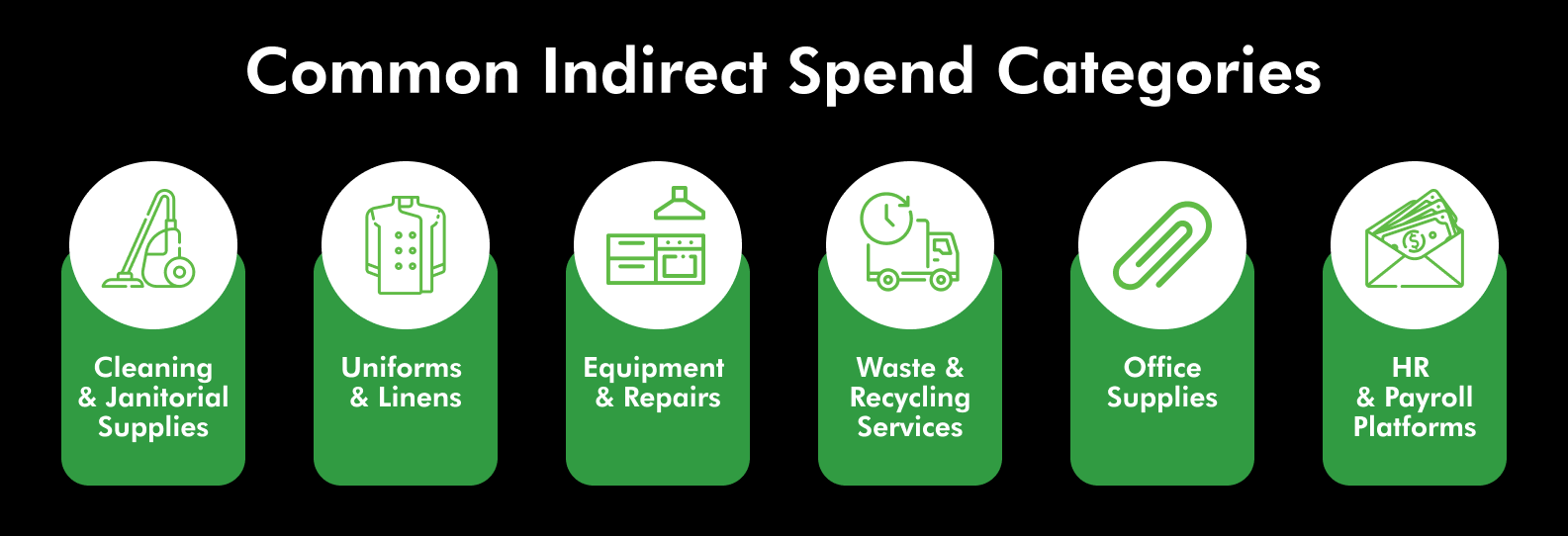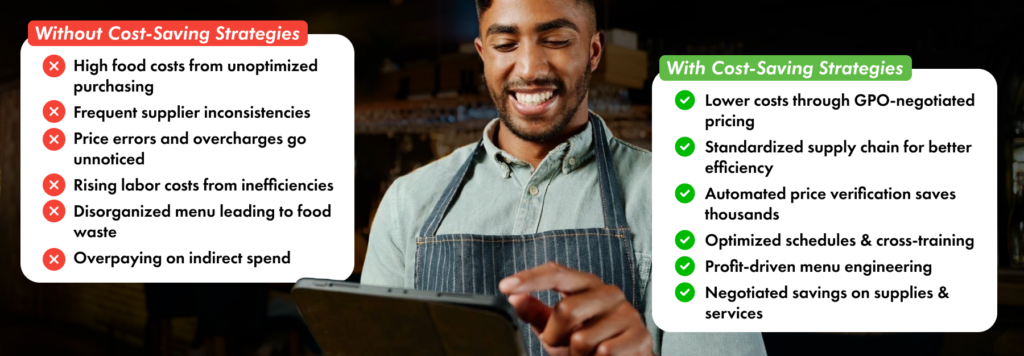How Restaurant Indirect Costs Quietly Erode Profitability
When operators think about profitability, food and labor usually take the spotlight—but restaurant indirect costs can quietly erode margins if left unmanaged.
From cleaning chemicals and uniforms to equipment repairs and payroll tools, these non-food essentials are easy to overlook. But across multiple locations, small inefficiencies in these categories can snowball into major operational expenses. And the bigger your restaurant footprint gets, the harder they become to track and control.
Optimizing restaurant indirect costs isn’t just about cutting back. It’s about gaining visibility, standardizing spend, and unlocking new savings to improve your bottom line.
Let’s break it down.
What Is Indirect Spend (and Why It’s So Easy to Miss)?
Indirect spend covers everything your restaurant purchases that isn’t food or beverage but is still critical to operations. It’s the cleaning supplies that get reordered every week. The uniforms you lease. The lightbulbs, trash bags, pest control, fryer oil disposal, and the software your team uses to track tips or schedules.
Individually, these may seem like small line items. But across multiple locations and months of service, these “minor” expenses can quickly add up—and chip away at your profitability without you realizing it.

Where the Dollars Disappear: Key Indirect Spend Categories
Here are some common indirect spend categories where multi-unit operators frequently overspend:
- Cleaning and Janitorial Supplies – Purchased as-needed, often without volume discounts
- Uniforms and Linens – Leased or bought at inconsistent prices from multiple vendors
- Equipment and Repairs – Emergency fixes and parts that vary widely by location
- Waste and Recycling Services – Missed contract renegotiations or inefficient pickup schedules
- Office Supplies and Admin Tools – One-off purchases without preferred pricing
- HR and Payroll Platforms – Different tools used by different units, adding unnecessary licensing costs
Without a centralized procurement strategy, these costs can spiral—especially when each location is ordering independently.
The Risk of Inconsistent Vendor Pricing Across Locations
When each unit manages its own indirect purchases, pricing can vary wildly—even for identical products. One location might pay 15% more for the same hand soap or trash liners simply because they’re sourcing from a different supplier or haven’t negotiated terms. That inconsistency adds up fast across 10, 20, or 50 units.
Consolidated Concepts helps standardize purchasing across your footprint so every location benefits from preferred pricing.

The Operational Toll of Managing Too Many Vendors
Multiple vendors mean multiple invoices, contracts, service issues, and account reps. It’s a heavy administrative load for your teams—and it gets heavier as you grow. Managing indirect spend without a centralized system not only wastes money but also valuable time your staff could spend on more strategic priorities.
With Consolidated Concepts, operators can simplify vendor relationships and reduce the burden on their teams.
How to Audit Restaurant Indirect Costs (Without Overwhelming Your Team)
If you’re not sure where your indirect dollars are going, here are three ways to get started:
- Run a Location-Level Spend Review – Pull purchasing reports from the last 3–6 months for each unit. Look at non-food categories—then compare vendors, pricing, and order frequency.
- Identify Repeat or High-Frequency Purchases – These are the quick wins. Items like gloves, napkins, chemicals, and software licenses are ripe for standardization and bulk savings.
- Consolidate Vendors Where Possible – Multiple vendors doing the same job = missed leverage. Streamlining vendors gives you more negotiating power and consistency.
How Consolidated Concepts Can Help You Take Back Control
At Consolidated Concepts, we help multi-unit operators uncover the restaurant indirect costs that are quietly eating into margins—and connect them to over 175,000 rebated and discounted line items that cover nearly every operational need.
Here’s how we support your business:
- Cost benchmarking to expose hidden overspending
- Vendor consolidation strategies to improve efficiency
- Access to pre-negotiated programs for everything from uniforms to waste services
- Purchasing data insights to optimize your indirect spend
Even if it’s not food, chances are—we can help you save on it.

Don’t Let the Small Stuff Slip Through the Cracks
Food and labor may get the spotlight—but indirect spend deserves a seat at the table. With the right strategy and support, you can rein in these hidden costs and boost profitability across every unit.
Let Consolidated Concepts help you uncover what you’ve been overlooking—fill out the form below and start saving smarter today.





